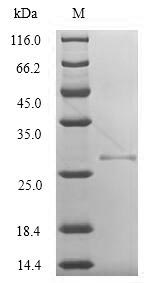Recombinant Vaccinia virus Protein K3 (VACWR034) comes from E. coli expression and includes an N-terminal 6xHis-SUMO tag that makes purification and detection straightforward. The complete protein spans amino acids 1-88 and shows purity levels above 90% when checked by SDS-PAGE analysis. This research-grade material appears optimized for experimental work where keeping endotoxin contamination low matters.
Vaccinia virus Protein K3 seems to play an important role in how the virus dodges host immune defenses. K3 likely disrupts the host's protein-making machinery, which may help the virus replicate and stick around longer. This makes it an interesting target for researchers studying viruses and immune responses. Learning how K3 works could reveal new details about how viruses cause disease and might point toward better antiviral treatments.
Potential Applications
Note: The applications listed below are based on what we know about this protein's biological functions, published research, and experience from experts in the field. However, we haven't fully tested all of these applications ourselves yet. We'd recommend running some preliminary tests first to make sure they work for your specific research goals.
Vaccinia virus K3 protein is a viral host defense modulator that likely requires specific folding for its interactions with host proteins (e.g., PKR). The E. coli expression system may produce soluble protein, but it cannot replicate the eukaryotic cellular environment or post-translational modifications necessary for native folding and activity. The SUMO tag may improve solubility but could sterically hinder functional domains. While the full-length sequence (1-88aa) is present, the probability of correct folding and functional activity is moderate but uncertain without experimental validation.
1. Antibody Development and Immunological Studies
This recombinant K3 protein serves as an excellent immunogen for generating antibodies specific to vaccinia virus K3. The full-length sequence ensures comprehensive epitope coverage, and the high purity minimizes antibodies against contaminants. The His-SUMO tag facilitates purification and screening. These antibodies will be valuable for detecting K3 in viral infection studies via Western blot or ELISA.
2. Protein-Protein Interaction Studies
Protein-protein interactions depend on precise tertiary structure. The SUMO tag and uncertain folding state make this application high-risk without prior validation. If correctly folded, the protein could identify physiological partners like PKR. However, misfolding or steric interference from the SUMO tag may lead to non-specific binding (false positives) or failure to interact (false negatives). Data interpretation requires validation with native protein.
3. ELISA-Based Binding Assays
This protein is highly suitable as an antigen for ELISA assays to detect antibody binding or screen antibody specificity. However, for functional binding studies (e.g., with host proteins), the protein must be correctly folded and active, which is uncertain. As an immunoassay reagent, the protein's sequence and purity are key; functional binding assays require activity confirmation.
4. Biochemical Characterization and Stability Studies
This is the essential first step to assess protein quality. Techniques like size-exclusion chromatography (SEC) can determine oligomeric state, while circular dichroism (CD) can analyze secondary structure and thermal stability. These studies provide critical data on folding and stability of the protein itself, not the native protein.
Final Recommendation & Action Plan
The recombinant K3 protein is reliable for antibody development and biochemical characterization but requires validation for functional studies. The immediate priority is Application 4 (Biochemical Characterization) to assess folding quality via SEC and CD. If the protein shows monodisperse behavior and structured spectra, proceed to validate activity (e.g., PKR binding assay). Once activity is confirmed, Applications 2 and 3 (functional binding studies) can be attempted. Application 1 (Antibody Development) can proceed immediately. Without activity validation, limit use to immunoassays and avoid interaction studies. This systematic approach ensures reliable results.






